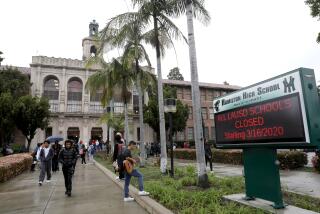ELECTIONS / OXNARD UNION HIGH SCHOOL DISTRICT : Educators Taking a Hard Look at Options
- Share via
Stung by the defeat of a $45-million bond measure, Oxnard Union High School District officials took a hard look Wednesday at cheaper but less attractive ways to ease classroom crowding than construction of a new high school.
The most likely option is to more than double the number of portable classrooms--now at 53--already at the district’s six campuses in Oxnard, Camarillo and El Rio.
Officials said they will also take another look at holding classes year-round, an option that would increase classroom capacity.
Supt. Ian Kirkpatrick said he has asked lawyers to determine if the district can back out of the purchase of a 50-acre site on Gonzales Avenue near Rose Avenue, where the new high school would have been built. Otherwise, the district faces a minimum $850,000 annual payment for the land.
“We hoped we wouldn’t have to talk about (other options),” Kirkpatrick said.
Only 56.2% of voters supported the ballot measure on Tuesday, far short of the required two-thirds majority. Of the district’s 97,719 registered voters, just 16.2% cast ballots in the one-issue special election that cost the district $100,000.
The measure did better in Camarillo (59.3%) than in Oxnard (56.9%). In one Oxnard precinct, only 45.5% of the voters supported the measure. But more than two-thirds of the voters approved it in two precincts near Leisure Village in Camarillo, at one precinct in El Rio and in the only precinct in Santa Rosa Valley.
Kirkpatrick said he would not recommend another bond election this year because the June and November ballots will be crowded with statewide bond issues. The district held the election Tuesday because officials thought that their chances were better with the low turnout that a single-issue ballot assures.
The district’s student enrollment of 11,743 is expected to grow to 13,980 by the fall of 1997. The schools are designed to accommodate only 10,600.
Bob Brown, district business manager, said leasing 67 additional portable classrooms over the next three years is the most practical way to ease crowding. Crowding would force boundary changes and more busing from one community to another within two years, Kirkpatrick said.
But with the 53 existing portables already spread among six high schools, Brown said some schools will soon have no place to put the new classrooms. Rio Mesa High School in El Rio will be the most likely candidate for the new classrooms because its 55-acre campus is the district’s largest, Brown said.
One portable classroom would cost the district $4,000 to lease per year, plus an additional $11,000 to install, Brown said. That would mean a cost of $300,000 for 20 portables for the coming school year, and $380,000 per year after that.
On Wednesday, the lack of space was apparent at Channel Islands High School, the district’s most crowded campus. Twelve portables are already on the south Oxnard campus. And Joanne Black, the assistant principal, said the only place left for portables is the central quad, where students who spill out of a cramped cafeteria eat lunch.
“Sometimes we don’t find a place to sit down,” said Claudia Martinez, 16, as she bit into a pizza.
The stresses and strains already experienced by Channel Islands students and staff members will spread to other high schools as enrollment climbs, officials said.
Channel Islands has 2,620 students, though the school was designed for about 2,200.
With such crowding, Black said, students “are close together. They bump into each other and they have more fights.”
And teachers can grow discouraged.
“When you have 38 students in an English class, you don’t have enough time in a day to grade all the papers. You don’t have enough books,” Channel Islands English teacher Marsha Craig said. She said the ideal number of students per classroom is 25.
Kirkpatrick said year-round instruction also could be an option. By dividing students into three or four groups and rotating them into school on different tracks, classrooms are occupied more often and capacity is increased. The school board has studied year-round programs and discarded the option as difficult to coordinate and bad for education.
But the district’s chances of getting school-construction money from the state are increased if a district moves to year-round instruction, state Department of Education officials said.
But district officials said year-round schools not only create scheduling problems, but would destroy school spirit and force the separation of students by academic ability, which the district opposes.
If the district begins year-round instruction and divides the students into four tracks, Kirkpatrick said problems would result because 3,000 pupils would be out of school at any one time.
Oxnard elementary schools now operate all year, but that does not help the high school district’s chances of getting state money for a new high school, state education spokesman Henry Heydt said. Brown said that information does not agree with his understanding of state guidelines.
The huge Los Angeles Unified School District increases capacity at six of its 49 high schools through its year-round programs. It has similar programs at 192 elementary and 17 junior high schools.
“It’s been working well for more than 10 years,” said Joyce Peyton, Los Angeles Unified’s district administrator.
Peyton said switching to year-round schools is more difficult for administrators than for students.
“It’s not easy, but, yes, we do manage,” she said. “Kids do learn, teachers get paid, students are achieving.”
Kirkpatrick’s response: “If we were year-round multitrack, I wouldn’t say anything bad about it either.”
More to Read
Sign up for Essential California
The most important California stories and recommendations in your inbox every morning.
You may occasionally receive promotional content from the Los Angeles Times.













